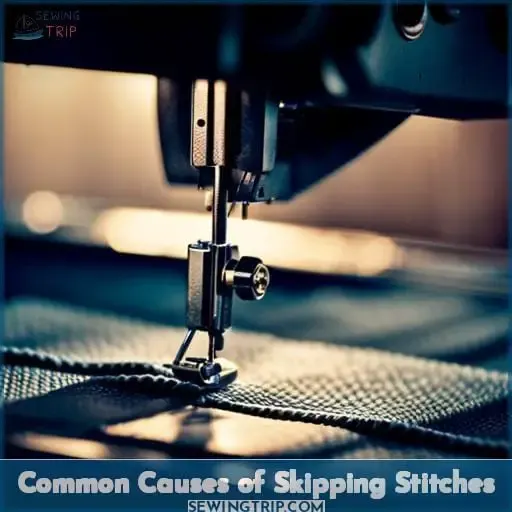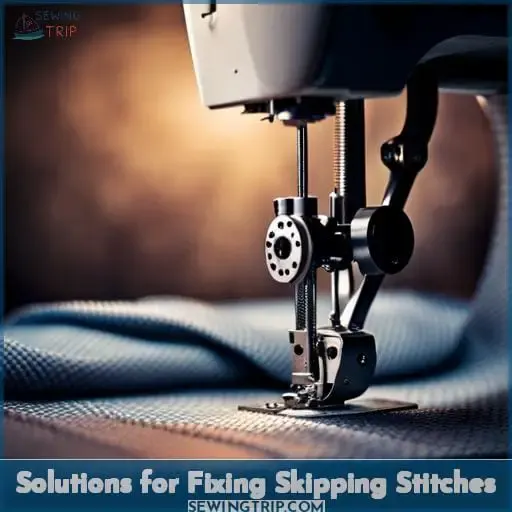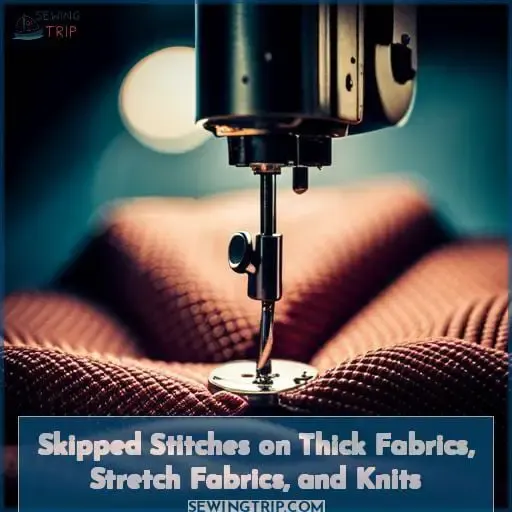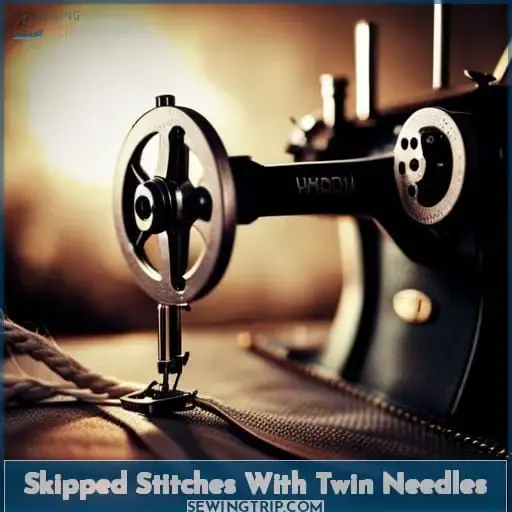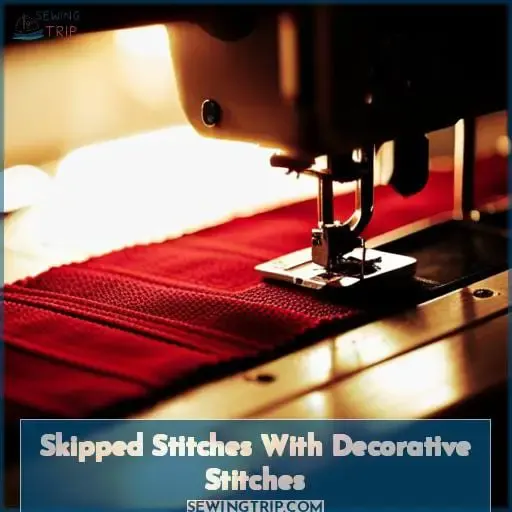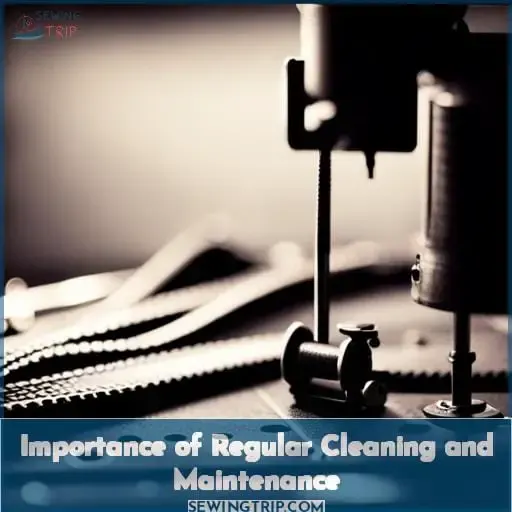This site is supported by our readers. We may earn a commission, at no cost to you, if you purchase through links.
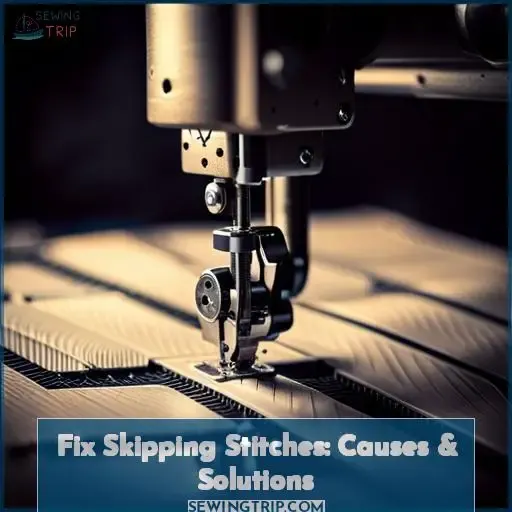 Discover the key to flawless sewing with our in-depth guide on fixing skipping stitches. Don’t let this frustrating issue hold you back from achieving professional-looking results. Skipped stitches weaken the integrity of your sewing, compromising durability and aesthetics.
Discover the key to flawless sewing with our in-depth guide on fixing skipping stitches. Don’t let this frustrating issue hold you back from achieving professional-looking results. Skipped stitches weaken the integrity of your sewing, compromising durability and aesthetics.
But fear not! We have compiled a comprehensive list of common causes and effective solutions to help you overcome this hurdle.
Incorrect settings for fabric, improperly wound bobbins, accumulation of dirt, thread type, and quality issues – these are just a few factors that can contribute to skipped stitches. By understanding each possible cause and following our step-by-step solutions, you’ll be able to troubleshoot your sewing machine like an expert.
Gain mastery over your craft by learning how different fabrics affect stitch formation or why an incorrect needle size can lead to skipped stitches. Our article also delves into specific scenarios like thick fabrics or decorative stitching where additional considerations come into play.
Unlock the power within as we reveal techniques for proper machine cleaning and maintenance that prevent future issues while ensuring smooth performance.
Table Of Contents
- Key Takeaways
- Common Causes of Skipping Stitches
- Solutions for Fixing Skipping Stitches
- Step 1: Prepare a Fabric Test Swatch
- Step 2: Change the Needle
- Step 3: Re-thread the Upper Thread
- Step 4: Check the Bobbin
- Step 5: Clean the Machine
- Step 6: Check Thread Quality and Type
- Step 7: Check Presser Foot
- Step 8: Adjust Tension Settings
- Step 9: Check Other Sewing Machine Settings
- Step 10: Slow Down When Sewing and Avoid Pulling Fabric
- Consider Repair or Investing in a New Machine
- Skipped Stitches on Thick Fabrics, Stretch Fabrics, and Knits
- Skipped Stitches With Twin Needles
- Skipped Stitches With Decorative Stitches
- Importance of Regular Cleaning and Maintenance
- Frequently Asked Questions (FAQs)
- Conclusion
Key Takeaways
- Properly wound bobbins are important for preventing skipped stitches.
- Regular cleaning and maintenance are crucial to prevent skipped stitches.
- The type and quality of thread impact stitch formation.
- Using the appropriate needle for the fabric type is essential to prevent skipped stitches.
Common Causes of Skipping Stitches
When experiencing skipped stitches on your sewing machine, there are several common causes to consider. These include incorrect settings for fabric, improperly wound bobbins, accumulation of dirt in the machine, using poor quality thread or the wrong type of thread for the project at hand, worn or damaged needles, sewing too fast without allowing proper stitch formation and tension adjustments to occur naturally.
Additionally, factors such as improper installation or using the wrong presser foot can also contribute to skipped stitches. Issues related directly to sewists’ actions, like pulling fabric when sewing and not correctly adjusting stitch length settings according to their chosen fabric’s weight and desired seam strength, can also lead to skipped stitches.
However, ultimately, timing being broken will require professional service attention.
Incorrect Settings for Fabric
When you’re sewing, make sure to adjust your settings properly for the fabric you’re working with.
- Threading techniques: Ensure that both the upper and lower threads are threaded correctly according to your machine’s instructions.
- Fabric compatibility: Different fabrics require different settings on your sewing machine.
- Troubleshooting tips: If you notice skipped stitches while sewing on a particular fabric, try adjusting the tension or using a different thread type or size.
- Needle selection: Using the correct needle size for your fabric is crucial in preventing skipped stitches. Choose a needle specifically designed for stretch fabrics if that’s what you’re working with.
Remember to regularly maintain and clean your sewing machine as well to prevent any issues that could lead to skipping stitches.
Incorrectly Wound Bobbins
If you wind your bobbins incorrectly, it’s almost like asking for perfect stitches to magically appear. Bobbins that are not wound tightly or evenly can cause skipped stitches in your sewing machine.
When the bobbin thread is unevenly wound, it can affect the tension adjustment and disrupt the smooth flow of thread through the machine. This inconsistency in tension can lead to skipped stitches as well as other stitching issues such as loose or tight stitches.
To prevent this problem, make sure to follow proper bobbin winding techniques and ensure that the bobbin is evenly filled with high-quality thread before inserting it into your sewing machine.
Accumulation of Dirt
To prevent frustrating interruptions in your stitching, make sure to regularly clean out any built-up dirt from your trusty sewing companion.
- Use a small brush or lint roller to remove loose debris and lint from the machine.
- Gently vacuum around the needle plate and bobbin area to get rid of any stubborn dust.
- Wipe down the exterior surfaces of the machine with a soft cloth dampened with water or a mild soap solution.
- Clean out thread residue by using canned air or blowing into hard-to-reach areas.
- Consider investing in a sewing machine cleaning kit that includes specialized tools for thorough maintenance.
By keeping your sewing machine free from dirt and debris, you can ensure smoother stitches and avoid skipped stitches caused by clogged mechanisms.
Thread Type and Quality
Upgrade your thread choice and opt for high-quality options to ensure smooth and flawless stitches. The type of thread you use, along with its quality, can greatly impact the performance of your sewing machine.
Choosing the right thread weight is important as well – thicker threads may cause tension issues while thinner threads can easily break.
Additionally, consider the color of your thread as it should match or complement your fabric to avoid visible stitching errors. Investing in good quality threads will not only prevent skipping stitches but also improve overall stitching results.
| Thread Selection | Impact on Stitches |
|---|---|
| Choose high-quality threads | Ensures smooth and flawless stitches |
| Consider matching or complementary colors between fabric and chosen thread | Avoids visible stitching errors |
Select appropriate weight:
- Thicker Threads
- Thinner Threads
Remember that using a low-quality or inappropriate type of thread may contribute to skipped stitches due to uneven feeding through the machine’s mechanisms. It is also essential to check if there are any tangles or knots in the bobbin before starting a new project as this can affect stitch formation too.
Worn or Damaged Needles
When your needles start to resemble a porcupine after a rough night out, it’s time to bid them adieu and replace them with fresh ones. Worn or damaged needles are a common cause of skipped stitches on sewing machines.
A bent or dull needle can struggle to pierce through the fabric properly, resulting in uneven stitches or skipped stitches altogether.
To troubleshoot this issue, check that you have the correct needle type and size for your fabric thickness. Additionally, inspect the needle closely for any signs of damage such as bends or burrs. Finally, always remember to regularly change your needles for optimal stitching performance.
Sewing Too Fast
Slow down your stitching speed to reduce the chances of skipped stitches.
- Adjust the stitch length to a shorter setting for thicker fabrics.
- Troubleshoot thread tension by checking and adjusting it accordingly.
- Regularly maintain your sewing machine, cleaning and oiling it as recommended by the manufacturer.
- Replace needles regularly to ensure they are sharp and in good condition.
Improper Installation or Wrong Presser Foot
To avoid the frustration of missed stitches, make sure your presser foot is working harmoniously with your machine. The proper installation and selection of a presser foot are crucial to prevent sewing machine skipping stitches.
Different presser foot options are available for various sewing techniques and fabric types. Refer to the troubleshooting guide provided by your sewing machine manufacturer for information on compatible presser feet and needle types.
Additionally, consider investing in presser foot accessories such as an adjustable zipper or walking foot to ensure smooth stitching across different fabric thicknesses.
Thread Tension Problems
Ensure your thread tension is properly adjusted to prevent any issues with the quality of your stitches. Common thread tension problems can lead to sewing machine skipping stitches and affect the overall stitch appearance.
To troubleshoot, start by checking if the upper thread is correctly threaded through all necessary guides and tension discs. Additionally, make sure that you’re using an appropriate needle for your fabric type as a dull or damaged needle can cause tension issues.
Adjusting thread tension may require small tweaks until you achieve balanced stitching without skipped stitches. Remember to test on a fabric swatch before starting your project and consider consulting your sewing machine’s manual for specific instructions on adjusting thread tension settings.
Incorrect Stitch Length Settings
Adjusting the stitch length is like finding the right rhythm for a dance, ensuring that each step flows smoothly and seamlessly.
- Check if the stitch length dial or settings are correctly positioned.
- Experiment with different stitch lengths to find what works best for your fabric.
- Remember that shorter stitches are generally used for delicate fabrics, while longer stitches work well on thicker materials.
- Be mindful of the compatibility of decorative stitches with certain fabric types.
If you’re experiencing skipped stitches due to incorrect stitch length settings on your sewing machine, try adjusting it according to these troubleshooting steps before seeking assistance from a machine technician.
Pulling Fabric When Sewing
When you pull the fabric while sewing, it can lead to frustrating and inconsistent stitches.
Proper fabric handling involves guiding the fabric gently through the machine without tugging or stretching it excessively. Sewing machine tension plays a crucial role in preventing skipped stitches caused by pulling fabric.
Make sure your tension settings are adjusted correctly for the type of material you’re working with.
Additionally, selecting the right needle for your project can also help prevent pulled threads and skipped stitches. Regular sewing machine maintenance, such as cleaning out built-up lint and ensuring there is no broken timing, will contribute to smoother stitching results when handling different fabrics like thick materials or knits that tend to cause thread shedding during sewing processes.
Broken Timing
To fix the issue of broken timing, consult a professional for repair as it accounts for approximately 15% of all sewing machine malfunctions. Timing issues can cause skipped stitches and other seam-related problems. Regular sewing machine maintenance can help prevent timing issues from occurring.
Troubleshooting skipped stitches may involve checking the needle plate and ensuring it is properly aligned with the bobbin case. Sewing machine accessories like screwdrivers or wrenches may be needed to adjust or replace parts related to timing problems in order to restore proper stitching functionality.
Solutions for Fixing Skipping Stitches
When experiencing skipped stitches on your sewing machine, there are several steps you can take to troubleshoot and resolve the issue. These include preparing a fabric test swatch, changing the needle, rethreading the upper thread, checking the bobbin, cleaning the machine, checking thread quality and type, inspecting the presser foot, adjusting tension settings as needed, examining other sewing machine settings for any errors or inconsistencies, slowing down while sewing and avoiding pulling fabric, and considering repair or investing in a new machine if all else fails.
Step 1: Prepare a Fabric Test Swatch
Prepare a fabric test swatch to ensure optimal stitching performance. Choose the appropriate needle for your fabric type. Re-thread the upper thread and inspect the bobbin for any issues. Clean your machine thoroughly before starting.
By following this troubleshooting guide, you can solve common sewing machine problems like skipping zigzag stitches effectively without frustration or wasted time.
Step 2: Change the Needle
Grab a fresh needle and get ready to effortlessly glide through your fabric, ensuring smooth and flawless stitches. When experiencing skipped stitches, changing the needle is often the solution. Different fabrics require different needle types and sizes, so choose one that matches your project’s needs.
Regular maintenance is crucial as worn needles can cause skipping stitches too. Replace dull or damaged needles promptly to avoid further issues with your sewing machine. Consider reputable brands known for their quality needles like Schmetz or Organ Needles to ensure optimal performance.
If using a twin needle and experiencing skipping stitches, check if it’s properly inserted in the bobbin case before replacing it with a new sharp one.
Step 3: Re-thread the Upper Thread
Next, you’ll want to ensure that the upper thread is smoothly flowing through the machine like a river of silk.
- Check the tension of the upper thread to ensure it is properly balanced.
- Carefully rethread the upper thread, following the correct threading path.
- Take a moment to check both ends of your bobbin and confirm that there are no tangles or knots present.
Step 4: Check the Bobbin
Check the bobbin for any issues that may be causing frustration and hindering your progress. Make sure the bobbin thread is properly wound and inserted into the bobbin case. Check for correct tension, as incorrect tension can lead to skipped stitches. Ensure the bobbin thread is catching properly during sewing to avoid any disruptions in stitching.
If necessary, back up a few stitches and rethread both upper and lower threads with compatible threads to prevent further skipping.
| Bobbin Issues | Emotional Response |
|---|---|
| Incorrectly Wound Bobbins | Frustration |
| Improper Bobbin Thread Tension | Hindrance |
| Bobbin Thread Not Catching Properly | Annoyance |
By checking these potential problems with your bobbin, you will have better control over your sewing machine’s performance.
Step 5: Clean the Machine
To keep your sewing project running smoothly, it’s important to give your trusty companion a good cleaning every now and then.
- Use a small brush or lint roller to remove lint and dust from the bobbin case, feed dogs, and other areas.
- Use compressed air or a vacuum with an attachment to clean hard-to-reach places like the tension discs and thread guides.
- Wipe down the exterior surfaces of the machine with a soft cloth dampened with mild soap and water.
Regularly cleaning your sewing machine not only prevents skipped stitches but also helps prolong its lifespan.
Step 6: Check Thread Quality and Type
Now let’s take a moment to assess the quality and type of thread you’re using. Did you know that using a high-quality thread can greatly reduce the chances of skipped stitches? Here are some important things to consider when it comes to your thread:
- Thread types and materials: Different fabrics require different thread types, such as cotton, polyester, nylon, or silk. Choose a thread that matches the fiber content of your fabric for optimal results.
- Thread tension troubleshooting: Incorrect tension settings can cause skipped stitches. Make sure your machine is properly threaded and adjust the upper tension if necessary.
- Choosing the right thread for your project: Consider factors like weight (thickness) and color when selecting a suitable thread for sewing purposes.
- Thread quality and durability: Invest in high-quality threads from reputable brands to ensure they are strong enough not to break or fray easily during sewing.
- Thread maintenance tips: Keep your threads stored in an area away from direct sunlight or moisture, which could potentially damage their integrity over time.
Step 7: Check Presser Foot
Examine the presser foot to ensure proper alignment and avoid potential stitching issues. Check presser foot types, proper installation, pressure adjustment, compatibility with the machine and attachments.
Step 8: Adjust Tension Settings
Ensure that the tension settings on your sewing equipment are properly adjusted to prevent any stitching issues. Adjusting tension is crucial in troubleshooting and fixing tension problems. Finding the right balance between upper and lower thread tensions can make a significant difference in preventing skipped stitches.
Mastering tension adjustment takes practice, but it’s worth it for smooth and even stitches. Experiment with different settings until you achieve the desired results. Make small adjustments at a time to avoid overcorrection or causing new issues.
Remember that each fabric may require slightly different tension settings, so take your time to find what works best for each project.
Step 9: Check Other Sewing Machine Settings
To optimize your sewing experience, take a moment to explore and adjust the various settings on your trusty stitching companion. Different sewing machine models may have specific settings that can affect stitch quality.
Refer to your sewing machine manual for guidance on adjusting bobbin tension, stitch length settings, and needle size compatibility. Experienced seamstresses recommend checking other settings such as presser foot pressure or feed dog height if you’re experiencing skipped stitches.
These small adjustments can make a big difference in achieving smooth and consistent stitches while avoiding frustration during your sewing projects.
Step 10: Slow Down When Sewing and Avoid Pulling Fabric
Take a moment to slow down your sewing pace and handle the fabric gently, as if you were guiding a delicate flower through a meandering path. This step is crucial in preventing skipped stitches and ensuring smooth stitching.
Here are some tips to keep in mind:
- Threading Technique: Double-check that the upper thread is properly threaded through all the guides and tension discs.
- Sewing Speed: Reduce your sewing speed when working with thick or difficult fabrics, allowing the machine to adequately penetrate each layer.
- Fabric Handling: Avoid pulling or stretching the fabric while sewing, as this can cause uneven tension and result in skipped stitches.
- Needle Selection: Use an appropriate needle size for your fabric type – an all-purpose needle should work well for most projects.
Remember, taking it slow and handling your fabric with care will go a long way in minimizing skipping stitches on your sewing machine.
Consider Repair or Investing in a New Machine
Consider exploring repair options or investing in a new sewing machine to address the issue of skipped stitches. Repair vs replacement depends on cost comparison, professional service recommendations, and factors to consider.
If your current machine is old or unreliable, investing in a new machine may be more beneficial in the long run. However, if it’s a newer and reliable model, getting it repaired by professionals can save you money.
Take into account the cost of repairs versus purchasing a new machine and weigh out which option makes more sense for you financially. Ultimately, choosing between repair or investment should be based on your specific needs and preferences when dealing with sewing machine skipping stitches.
Skipped Stitches on Thick Fabrics, Stretch Fabrics, and Knits
When working with thick fabrics, stretch materials, or knits, you may encounter the frustration of your stitches taking a detour. It’s like navigating through a dense forest where every step feels uncertain and unpredictable.
But fear not! There are adjustments and tools that can help you conquer this stitching challenge.
Here are some tips to prevent skipped stitches on thick fabrics:
- Adjusting needle size: When sewing on thicker materials, using a larger needle can make a significant difference. A thicker fabric requires more space for the thread to pass through without getting stuck or skipping stitches.
- Using the right type of needle: Different needles have different purposes. For example, ballpoint needles are ideal for knit fabrics as they penetrate between the fibers rather than piercing them outright.
- Choosing appropriate stitch length: Longer stitch lengths allow more room for each stitch to form properly without pulling or skipping over bulky areas in thick fabrics.
And here’s how you can tackle skipped stitches on stretch fabrics:
- Stabilizing with interfacing: Applying lightweight interfacing before sewing will give stability and prevent stretching during stitching. This helps maintain consistent tension throughout your seams and reduces the chances of skipped stitches.
- Experimenting with differential feed settings: If your machine offers it, adjusting differential feed settings can help control stretching by feeding fabric layers at different rates while maintaining proper tension across all layers evenly.
Troubleshooting knit fabric issues require attention too:
- Opting for zigzag stitch patterns: Knit fabrics tend to have more give compared to woven ones; therefore utilizing zigzag stitching allows flexibility in movement without causing stress on stretched seams which could lead to missed stitches.
Lastly, having specialized tools such as walking feet or even-feed presser feet is highly recommended when working with these challenging textiles. These attachments ensure even feeding of both top and bottom layers simultaneously, reducing any slipping that often results in dreaded skipped stitches.
By implementing these adjustment techniques into your sewing routine, you can prevent skipped stitches on thick fabrics, find solutions for stretch materials, and troubleshoot knit fabric issues. These tools give you the power to overcome any stitching obstacles that come your way, allowing you to master the art of sewing with confidence.
Skipped Stitches With Twin Needles
If you’ve been experiencing skipped stitches while using twin needles, there are a few factors that may be causing this issue. One possibility is that your needles are dull or worn out. Dull needles can struggle to penetrate the fabric properly, leading to skipped stitches.
It’s important to regularly change your sewing machine needles to ensure optimal performance.
Another factor that could contribute to skipped stitches with twin needles is weak upper tension. If the tension on your machine isn’t set correctly, it can result in uneven stitching and missed loops of thread.
Adjusting the upper tension according to the manufacturer’s instructions for working with twin needle setups can help prevent this problem.
To further prevent skipped stitches when using double or twin needles on stretchy knit fabrics, consider using a ballpoint needle specifically designed for these types of materials. Ballpoint or jersey needles have rounded tips that glide between fibers without damaging them.
In addition to making sure you’re using sharp and appropriately sized twin needles for your project, regular sewing machine maintenance is crucial in preventing skipping stitches overall. As mentioned earlier, cleaning lint, dust, and debris from within, below, and around the presser foot area will keep everything running smoothly.
Taking good care of our machines also means ensuring proper lubrication if needed. Regularly oiling rotary hook mechanisms as specified by manufacturers helps reduce friction, which prevents undue strain during operation, later resulting in fewer problems such as skip-stitch.
You should always consult the user manual before applying any kind of lubricant to avoid potential damage.
So remember, take time to regularly maintain your trusty workhorse and give back years of reliable service!
Skipped Stitches With Decorative Stitches
When experiencing skipped stitches with decorative stitches, it’s important to consider similar factors as straight stitches. Factors such as incorrect settings for fabric, thread type and quality, and worn or damaged needles can all contribute to this issue.
Additionally, keep in mind that the chosen stitch design may be too much for the thickness of the fabric being used.
Similar Factors as Straight Stitches May Be Involved
To prevent skipped stitches with decorative designs, make sure to address the same factors that can affect straight stitches.
- Thick fabric solutions: When working with thick fabrics, consider using a larger needle size or a specially designed stretch needle to accommodate the thickness.
- Needle selection: Ensure that you’ve selected the appropriate needle for your project. A dull point or incorrect needle type can cause skipped stitches in decorative designs.
- Stretch fabric adjustments: If you’re sewing on stretch fabrics, adjust your machine’s settings accordingly. Use longer stitch lengths and test different tension settings to ensure smooth stitching without skips.
- Maintenance tips: Regularly clean and oil your sewing machine as advised by its manufacturer’s instructions. It helps keep all parts moving smoothly, which reduces the chances of skipping stitches while doing embroidery work.
Remember, when dealing with skipped stitches in decorative designs, it’s important to address these factors along with other common issues like thread quality, type, and proper installation of the presser foot.
Fabric Thickness May Be Too Much for the Chosen Stitch Design
Consider using a different stitch design if your fabric is thick, as it may be too much for the chosen stitch. Can decorative stitches handle the thickness? Stitch design challenges arise when working with dense fabrics that require special stitching techniques.
To overcome this, start by choosing the best embroidery needle suited for sewing heavy fabrics. The right needle selection can make all the difference in achieving successful decorative stitches on thick materials.
Another factor to consider is machine compatibility; ensure that your sewing machine can handle thicker fabrics and has appropriate settings for decorative stitching on such materials.
By being mindful of fabric thickness and making informed choices about stitch design, you can achieve beautiful results even with challenging materials.
Importance of Regular Cleaning and Maintenance
Regular cleaning and maintenance of your sewing machine is essential to prevent skipped stitches. However, if you are experiencing timing issues with the machine, it may be necessary to seek professional service for correction.
Prevents Skipped Stitches
Regular cleaning and maintenance of your sewing machine is crucial to keep it running smoothly and prevent any interruptions in your stitching.
- Sewing Machine Maintenance: By keeping your sewing machine clean, you can ensure that dirt, lint, or thread buildup doesn’t interfere with the smooth movement of the needle and fabric. Regularly remove dust, lint, and debris from the bobbin case area as well as other parts of the machine.
- Troubleshooting Skipped Stitches: Cleaning also allows you to identify any potential problems before they become major issues. Check for bent or dull needles that may need replacing since a damaged needle can cause skipped stitches.
- Sewing Machine Accessories: Alongside routine cleaning tasks such as changing needles regularly (using a specialty needle like ballpoint embroidery if necessary), accessories like seam aids or jean-a-ma-jigs make it easier to sew over thick fabrics without experiencing skipped stitches.
By adopting these simple fixes into your regular sewing routine—such as using appropriate tools/accessories for thick materials—regular cleaning will become second nature while preventing unnecessary frustration during creative projects by reducing instances of skipping stitches.
Timing Issues May Require Professional Service
If your timing is off, it may be best to seek professional service for adjustments. Timing issues with a sewing machine can lead to skipped stitches and other problems. A skilled technician will have the expertise to diagnose and fix any timing issues that may be causing skipped stitches.
They will ensure that the needle and hook are synchronized properly, allowing for smooth stitching without skips or jumps.
Regular sewing machine maintenance can help prevent timing issues from occurring in the first place by keeping all components clean and well-lubricated. However, if you find yourself troubleshooting skipped stitches despite regular maintenance, it’s important not to attempt fixing the timing on your own unless you have experience working through common reasons like false starts or thread cutter malfunctions as improper adjustment could cause more harm than good.
| Common Causes of Timing Issues | Possible Solutions |
|---|---|
| Incorrect installation of needle | Reinstall needle correctly |
| Broken or worn-out hook mechanism | Replace broken parts |
| Machine has been dropped or mishandled | Check for damage; repair if necessary |
Seeking professional assistance ensures that these complex repairs are done correctly so you can get back to enjoying uninterrupted sewing sessions without worrying about skipping stitches ruining your projects.
Frequently Asked Questions (FAQs)
Can skipped stitches be caused by using the wrong type of thread?
Using the wrong type of thread can indeed cause skipped stitches on a sewing machine. Factors such as thread thickness, composition, and quality can affect stitch formation. It is important to choose a suitable thread for your fabric to prevent this issue.
How do I know if the timing of my sewing machine is off?
If your sewing machine is skipping stitches, one possible cause could be the timing being off. Signs to look for include the needle hitting the bobbin case or hook, uneven and inconsistent stitches, or thread breakage.
Are there any specific adjustments or tools needed for sewing with thick fabrics, stretch fabrics, and knits?
When sewing with thick fabrics, stretch fabrics, and knits, it is important to make specific adjustments. Use a walking foot or a specialized tool like the Hemline Bulky Seam Aid or Dritz Jean-A-Ma-Jig Original for better stitch quality and even feeding of layers.
What should I do if I notice skipped stitches when using twin needles?
If you’re experiencing skipped stitches when using twin needles, there are a few things you can try. First, make sure your needles aren’t dull and that the upper tension is properly adjusted. If the issue persists, consider seeking professional service or investing in a new machine.
How often should I clean and maintain my sewing machine to prevent skipped stitches?
To prevent skipped stitches, clean and maintain your sewing machine regularly. It is recommended to clean it after every project or at least once a month. Regular maintenance helps remove dirt, lint, and thread buildup that can cause stitching issues.
Conclusion
To fix skipping stitches on your sewing machine, it’s important to identify the common causes and apply the appropriate solutions.
Incorrect settings for fabric, improperly wound bobbins, dirt accumulation, thread type and quality, worn or damaged needles, sewing too fast, improper installation or wrong presser foot, thread tension problems, incorrect stitch length settings, and pulling fabric when sewing are all potential culprits.
By preparing a fabric test swatch, changing the needle, re-threading the upper thread, checking the bobbin, cleaning the machine, and adjusting tension settings, you can address these issues.
Additionally, be mindful of specific challenges when working with thick fabrics, stretch fabrics, and knits, as well as twin needles and decorative stitches.
Regular cleaning and maintenance are essential to prevent skipped stitches, but if you encounter timing issues, professional service may be necessary.
Remember, WonderFil Specialty Thread offers educational resources to enhance your sewing experience. With these tips and tools, you can overcome the frustration of skipped stitches and achieve smooth and professional results in your sewing projects.

